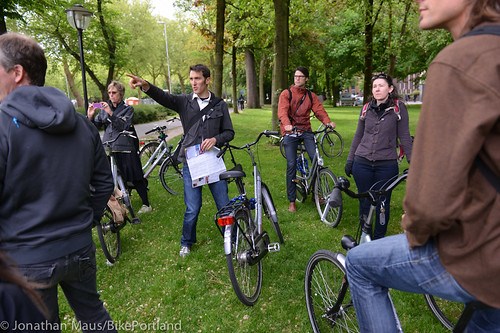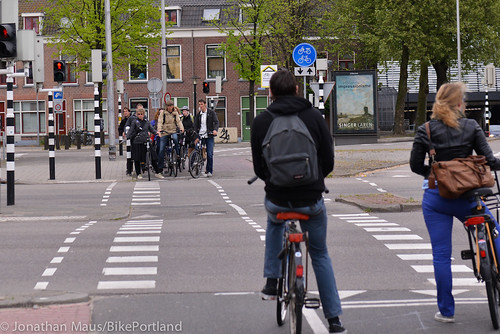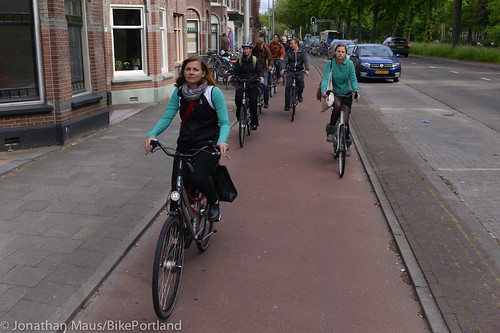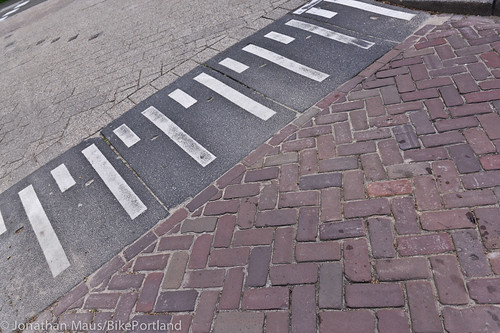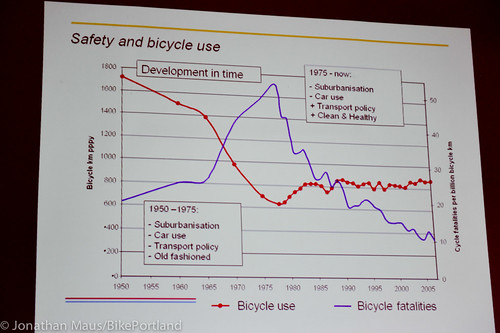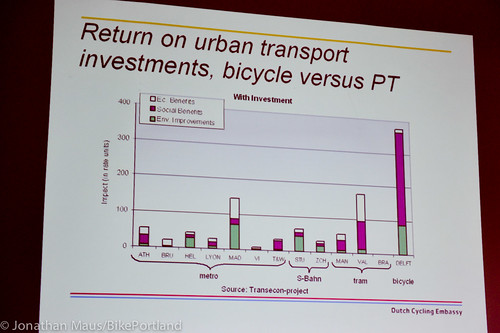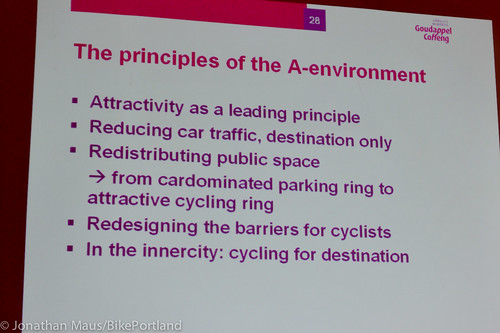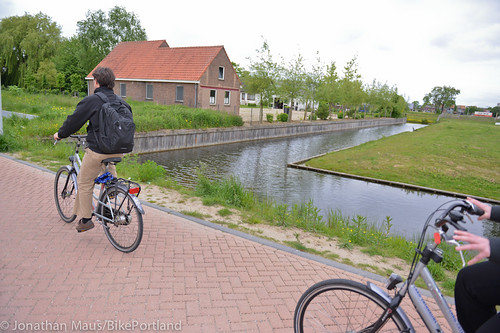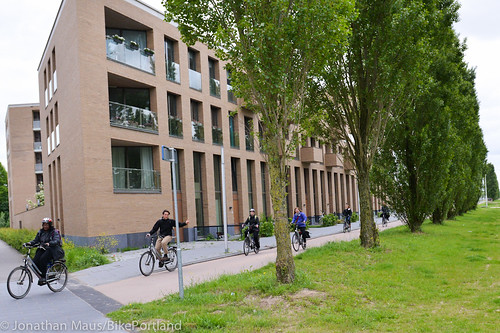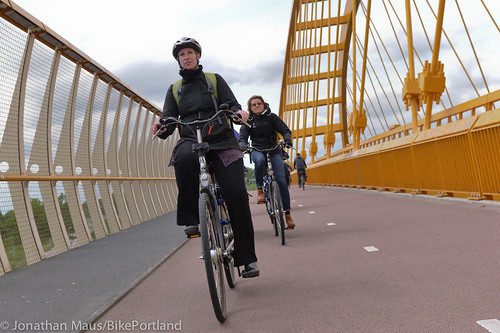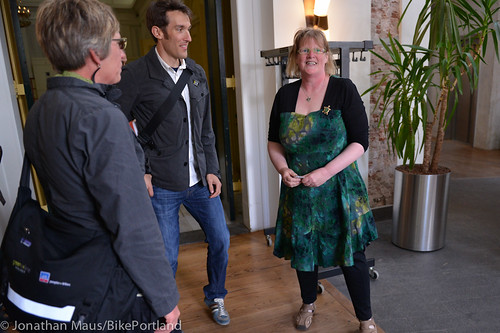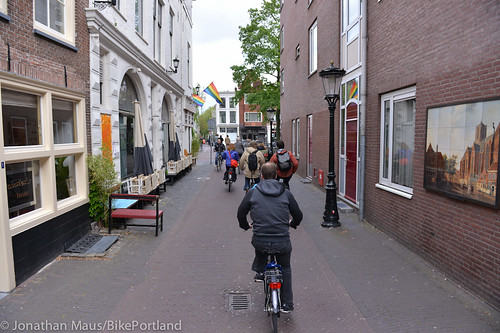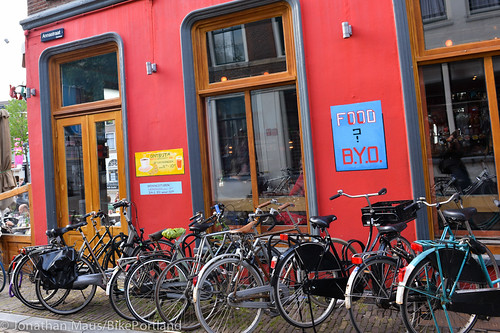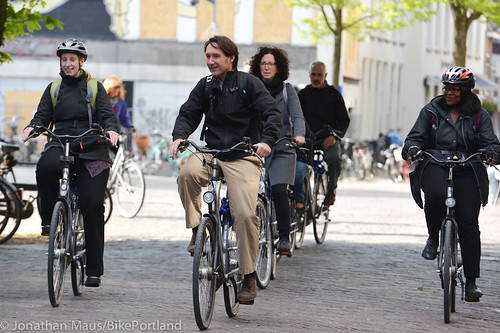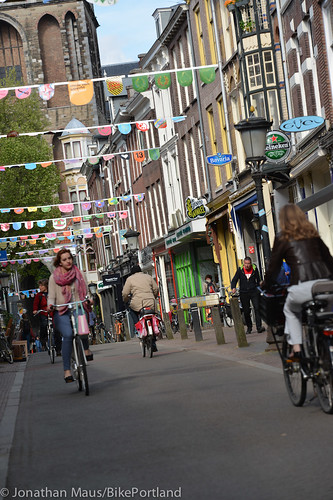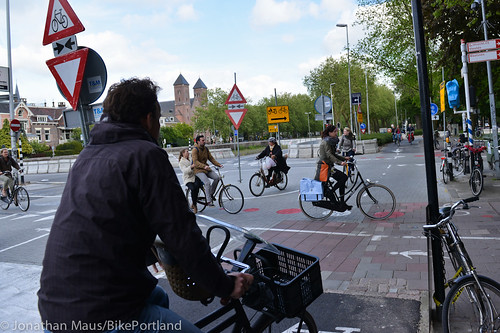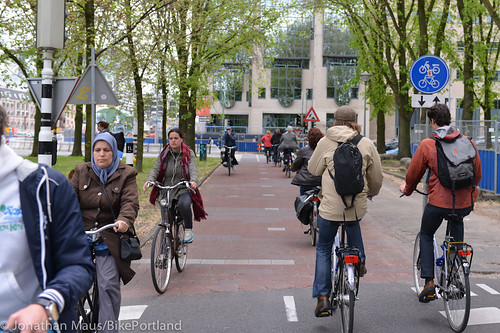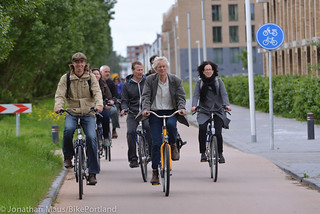
from downtown Utrecht to a large housing development.
(Photos © J. Maus/BikePortland)
This is part of ongoing coverage of the Green Lane Project/Bikes Belong Netherlands Study Tour.
The secret to success of cycling in the Netherlands is their practical approach. Somehow, while the United States suffers from a car-centric transportation and road design culture, the Dutch have managed to find a much more humane and effective balance. During the first day of our study tour in Utrecht today we learned the basic building blocks of the Dutch approach to transportation policy and we got a first-hand look at how that translates onto the street.
Our local host is Tom Godefrooij a veteran of bicycle advocacy and policy in the Netherlands who currently works with the Dutch Cycling Embassy, an organization set up to export the country’s bike-friendly ways. Tom shared their “cycling inclusive planning” approach; but one of the big takeaways for the groups today is that it’s not just about the bike in the Netherlands. “We are looking for the optimal mix,” is how Tom put it. Each mode — biking/walking, public transport, and cars — has its strengths and weaknesses. What the Dutch do well is to plan their system so that it makes best use of each mode.
That being said, bicycling is firmly cemented into their national and local policy and planning decisions. The reason for this is a practical one. When the Netherlands experienced a huge influx of automobiles in the 1970s, roads got jammed and citizens revolted as fatalities and injuries skyrocketed. The Dutch realized that they couldn’t build their way out of this problem, so they returned to something they knew very well: bicycling.
Here are a few photos and notes from our ride:
Zach Vanderkooy (center) is in charge of international education programs for Bikes Belong…
Metro Councilor Sam Chase (left) and BTA Director of Advocacy Gerik Kransky…
Dutch intersections are legendary in bike planning circles…
Here’s a typical Utrecht cycle track…
And a traffic-calmed, shared street being enjoyed by SFMTA Board Member Leona Bridges (left) and Jennifer Matz, the Director of Waterfront Development for the City of San Francisco…
They use texture to help calm traffic and designate different types of streets/zones..
This simple treatment is known as an “advisory bike lane.” It’s a two-way roadway, but notice there’s no centerline. That forces people in cars to slow down and negotiate oncoming traffic. The bike lane is also dashed which means people driving cars can move into it when no one is present…
As the Dutch invested in bicycling, road deaths plummeted, streets became more accessible, and quality of life improved. Today they have some of the safest and most bike-friendly roads in the world. They’ve also run the numbers and have found that the return-on-investment for bicycle projects — when you combine the economic, environmental, and social benefits — far outpaces that of public transport projects:
The Dutch success seems simple when you see it in a slide presentation. They have three basic types of streets or “mobility environments”: flow (arterials), distributor (collectors), and access (local/residential streets). These three environments are also sometimes referred to as A, B, and C. The key tenets of their approach is that in local access (A environment) streets, bicycling and walking are prioritized and cars are treated as “guests”; in the B environment it’s all about balancing modes; and in the C environment complete segregation is necessary.
When it comes to safety, Tom explained that they avoid three things: differences in mass, speed, and direction. These three basic roadway types, mixed with a few core principles result in a system that works. While safe streets are the end result, “safety” gets much less focus in their policy approach. “Safety is not a goal of cycling policy,” Tom said, “It’s a precondition.” The main argument for a good cycling policy is that making trips by bike is simply the most practical and efficient choice.
We experienced this first-hand when hopped on our rental bikes and headed for Leidse Rijn, a new 31,000 unit housing, office, and industrial development a few kilometers outside of Utrecht’s city center. We rode on separated cycle track nearly the entire way. Like a highway for cars leads to the suburbs in the U.S., a two-way cycle track delivers people on bikes to this development. Once inside the development we rode on traffic-calmed streets that are easily shared between people in cars and on bikes.
The Dutch purposely leave existing elements in place when they develop a large new parcel of land. Tom says these are “special elements that help enrich an otherwise boring development.”
The cycle track connects directly to thousands of housing units…
This is a typical shared street…
There’s no shortage of connections and access options for people on bikes; but there’s limited access for people in cars…
Executive Director of Venture Portland Heather Hoell rides on a bridge path right outside of town…
After our ride to Leidse Rijn we made our way back to the city center for a stop in Utrecht City Hall where we heard from more experts on Dutch cycling policy including the Transportation Commissioner of Utrecht.
— Stay tuned for more stories from Europe. Read more coverage here.


